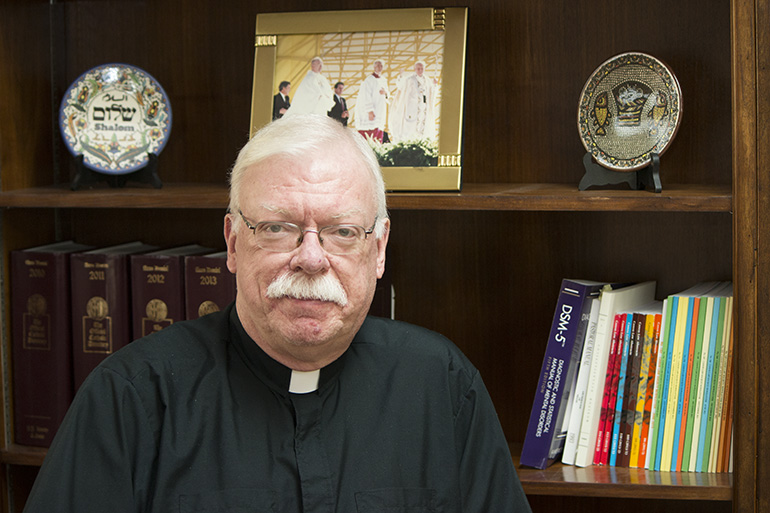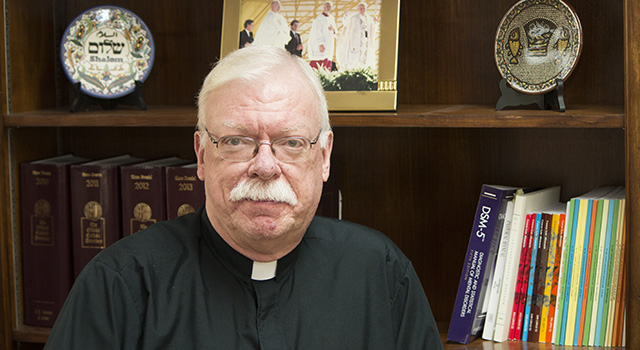By Ana Rodriguez Soto - The Archdiocese of Miami

Photographer: ANA RODRIGUEZ-SOTO | FC
Msgr. Gregory Wielunski, a priest of the Diocese of Brooklyn, N.Y., took over as judicial vicar in the Archdiocese of Miami at the end of October 2015.
MIAMI | A priest’s role: to save souls. That’s what Msgr. Gregory Wielunski does, but not in the conventional way.
The Brooklyn priest is the Archdiocese of Miami’s new judicial vicar, taking over from Msgr. George Puthusseril at the end of October 2015. As judicial vicar, he ministers chiefly through canon law, meting out justice tempered by mercy.
It’s not how he first pictured his priestly life. When he was ordained, Feb. 18, 1978, his passions were music and liturgy. He had been working at Sacred Heart Parish in Bayside, N.Y., when his bishop, the late Francis Mugavero, called him into his office in 1982. The bishop told him he was sending him to the Catholic University of America in Washington, D.C., to study canon law.
“I’m sitting there saying, what? Did you really think about this?” Msgr. Wielunski recalled. But “I never argue with a Sicilian boss.”
So after getting his canon law degree, he began working fulltime in the Brooklyn Tribunal. From 1984 to 2009, he served in every capacity: as advocate, as defender of the bond, as judge and as adjutant (associate) judicial vicar. He took a two-year break from 1994 to 1996 to obtain a doctorate in canon law at Rome’s Angelicum University.
From 1986 to 1993, he also taught marriage law at the Cathedral Seminary of the Immaculate Conception.
“Never thought I would do that either,” Msgr. Wielunski said. “I did everything to try to get out of it.” But after the first year, he recalls thinking, “I’m really enjoying this.”
Even when he was named pastor of St. Pancras Parish in Glendale, Queens, in 2009, he continued to help out as a tribunal judge for the neighboring Diocese of Newark.
In 2015, Brooklyn’s current Bishop Nicholas DiMarzio, a good friend of Archbishop Thomas Wenski, asked him if he would be interested in getting back into canon law fulltime � in Miami.
“Yeah,” he said.So he now resides at St. Rose of Lima in Miami Shores, a short commute from the Tribunal offices in the archdiocesan Pastoral Center. As judicial vicar, he is “the principal canonical consultant” in the archdiocese.
“The diocesan bishop is the first judge of all in the diocese,” Msgr. Wielunski explained. But the archbishop relies on his expertise whenever questions of canon law arise.
Most of the time, the tribunal handles marriage annulment cases. As judicial vicar, Msgr. Wielunski oversees an office of more than a dozen canon lawyers, six administrative staff and a broad network of trained advocates, people at the parish level who guide Catholics through the annulment process.
Although few people connect law with mercy, that’s precisely the role of the Tribunal, especially when it involves annulments.
The Church teaches that Christian marriage is indissoluble. But “how do we deal with marriages that have broken down?” Msgr. Wielunski said.
In mercy, the Church sets “no time limit” for looking into whether a marriage was sacramentally valid. Either partner can petition for an annulment once a civil divorce is finalized � or decades later.
Yet “even being merciful, we have to go to the bottom line of the sacramentality and indissolubility of marriage, which comes from the Gospel itself,” Msgr. Wielunski said.
So in deciding whether there are grounds for an annulment, Tribunal officials look at “what was the relationship right from the beginning? Did it contain all the essential elements?” he explained.
The Church does not make its decision based on what happened after the wedding but on the frame of mind and emotional capacity of the couple when they said “I do.” Thus the distinction between an annulment � a ruling that a valid sacramental marriage never took place � and a divorce, which is the dissolution of a civil contract.
The grounds for determining that a marriage was not truly a sacrament are outlined in the 1982 Code of Canon Law. It incorporates the “better understanding of what marriage is” that came out of the teachings of the Second Vatican Council.
Some people have a problem with that, Msgr. Wielunski acknowledged.
“People’s opinion is that (tribunals) are too lenient. However, I don’t believe that. We do a critical evaluation, a critical investigation, to the best of our abilities,” he said.
Aside from the obvious reason � that there are more divorces � there are also more annulments now because “to their credit,” the U.S. bishops have invested heavily in training priests and lay people for tribunal work, Msgr. Wielunski said.
It’s what Pope Francis wants to see happen throughout the world. Last year, he highlighted the merciful aspects of tribunal work by instituting reforms to streamline the process and make it more affordable.
Now, cases can originate in the diocese where the petitioner or respondent lives � not where the wedding was celebrated, and without seeking additional permissions from the other diocese.
Also, declarations of nullity no longer have to be reviewed by a “second instance” tribunal � sort of an automatic appeals process. The decision is only subject to review when one of the parties requests it.
The pope also called for the entire process to be free of charge, although he has acknowledged the need to pay fair wages to tribunal staff, many of whom are lay people.
Msgr. Wielunski praised Pope Francis’ initiatives and reiterated that, while the tribunal continues to charge a fee, “that has nothing to do with the outcome (of the case). And if people can’t afford that, all tribunals have made arrangements for reducing the fees or dropping it for certain individuals.”
As canon law states: “�the salvation of souls � (is) the supreme law in the Church.” (Can. 1752)

